托福阅读-事实信息题PPT课件
- 格式:ppt
- 大小:107.00 KB
- 文档页数:23
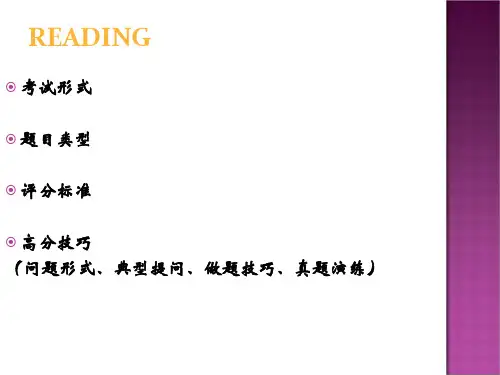
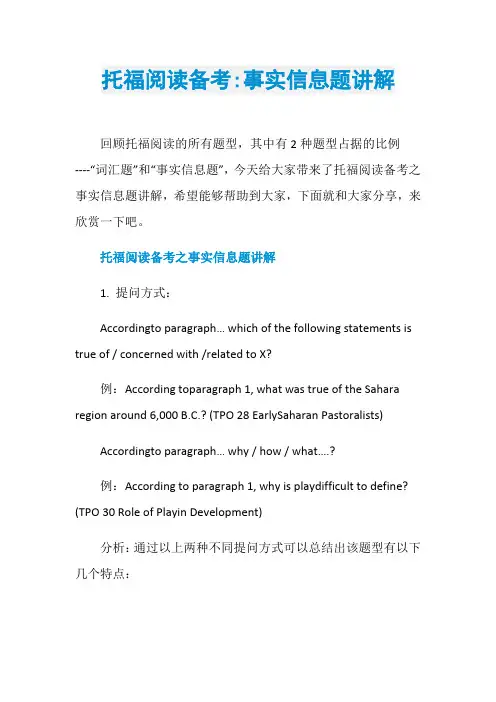
托福阅读备考:事实信息题讲解回顾托福阅读的所有题型,其中有2种题型占据的比例----“词汇题”和“事实信息题”,今天给大家带来了托福阅读备考之事实信息题讲解,希望能够帮助到大家,下面就和大家分享,来欣赏一下吧。
托福阅读备考之事实信息题讲解1. 提问方式:Accordingto paragraph… which of the following statements is true of / concerned with /related to X?例:According toparagraph 1, what was true of the Sahara region around 6,000 B.C.? (TPO 28 EarlySaharan Pastoralists) Accordingto paragraph… why / how / what….?例:According to paragraph 1, why is playdifficult to define? (TPO 30 Role of Playin Development)分析:通过以上两种不同提问方式可以总结出该题型有以下几个特点:1). 该题型是就某段话当中的某个细节信息(即提问方式1中的X)进行提问。
2). 该题型可以围绕该细节信息的不同方面进行提问,通过特殊疑问词which;what; why; how可以看出。
3). 由于题干中未出现infer;suggest; indicate等字样,所以该题型旨在考察文本信息的字面含义,无需考生进行文本的隐含意推理。
2. 解题步骤:Step 1: 读题干,找出定位词注意:如果是提问方式1, 那么定位词则是位于介词of/with/ to后面的信息。
如果是提问方式2, 那么定位词一般是名词,并且是非主题性的名词(当然定位词不一定只能找一个,一般可以找2到3个,因为定位词越多相对定位的位置也会越。
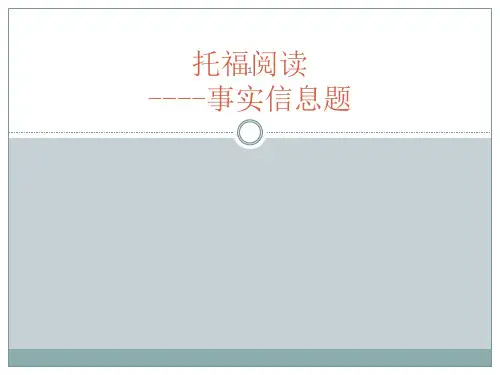
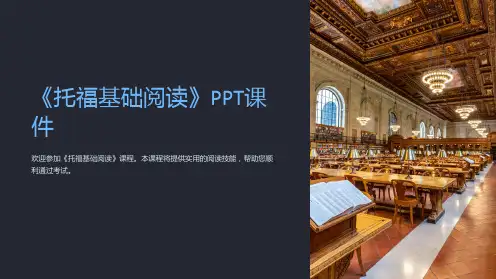

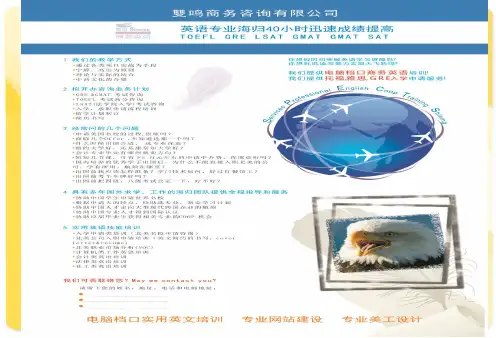

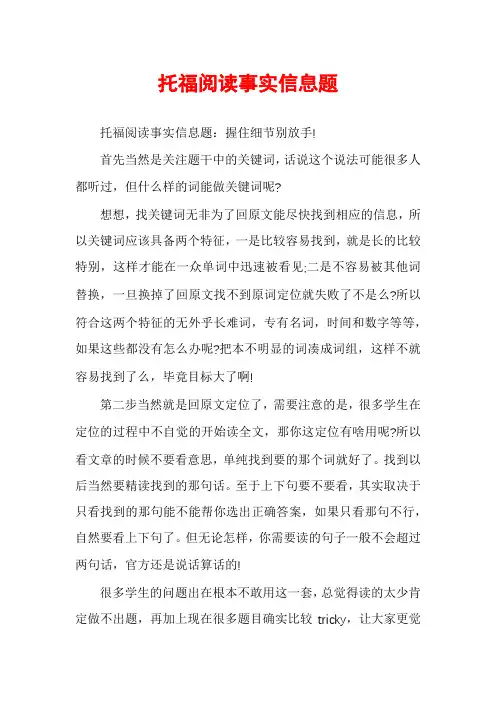
托福阅读事实信息题托福阅读事实信息题:握住细节别放手!首先当然是关注题干中的关键词,话说这个说法可能很多人都听过,但什么样的词能做关键词呢?想想,找关键词无非为了回原文能尽快找到相应的信息,所以关键词应该具备两个特征,一是比较容易找到,就是长的比较特别,这样才能在一众单词中迅速被看见;二是不容易被其他词替换,一旦换掉了回原文找不到原词定位就失败了不是么?所以符合这两个特征的无外乎长难词,专有名词,时间和数字等等,如果这些都没有怎么办呢?把本不明显的词凑成词组,这样不就容易找到了么,毕竟目标大了啊!第二步当然就是回原文定位了,需要注意的是,很多学生在定位的过程中不自觉的开始读全文,那你这定位有啥用呢?所以看文章的时候不要看意思,单纯找到要的那个词就好了。
找到以后当然要精读找到的那句话。
至于上下句要不要看,其实取决于只看找到的那句能不能帮你选出正确答案,如果只看那句不行,自然要看上下句了。
但无论怎样,你需要读的句子一般不会超过两句话,官方还是说话算话的!很多学生的问题出在根本不敢用这一套,总觉得读的太少肯定做不出题,再加上现在很多题目确实比较tricky,让大家更觉得无所适从,但请相信,既然官方说了只看一两句能选出答案,绝大多数情况下就一定可以。
考生们的问题更多在于找不到或者好容易找到却看不懂,看不懂的孩子请好好背单词,毕竟巧妇难为无米之炊,没有一定的单词量再多的技巧也没用!至于找不到的同学,并不是这个方法本身出了问题,而是关键词很多时候不那么明显了。
那么问题又来了,找不到关键词应该怎么办?很多童鞋可能知道,托福考试中题目出现的顺序和文章行文的顺序是一致的,直接点儿说,就是一段的第一题极有可能出现在这段的最前面,以此类推。
知道了这个,就意味着即使没有关键词,你也可以根据这题是这段的第几题来大致确定到底要读段落的前半部分。
中间,还是后半部分;还可以根据上一题的大概位置往下找这一题的答案,这样会使读文章的压力大幅减轻。
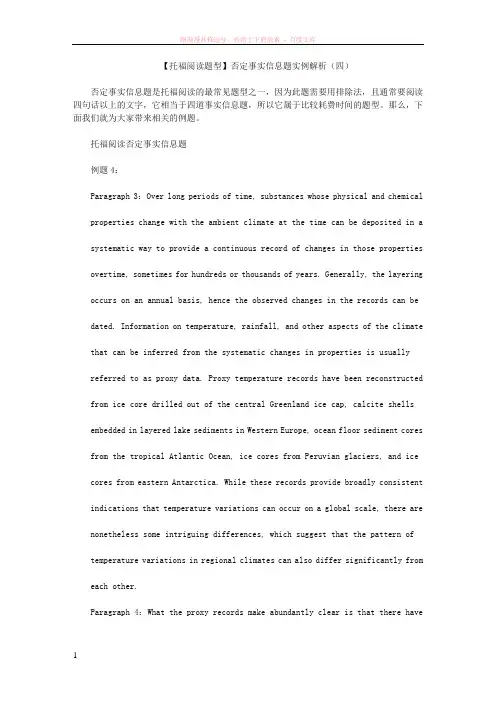
【托福阅读题型】否定事实信息题实例解析(四)否定事实信息题是托福阅读的最常见题型之一,因为此题需要用排除法,且通常要阅读四句话以上的文字,它相当于四道事实信息题,所以它属于比较耗费时间的题型。
那么,下面我们就为大家带来相关的例题。
托福阅读否定事实信息题例题4:Paragraph 3:Over long periods of time, substances whose physical and chemicalproperties change with the ambient climate at the time can be deposited in asystematic way to provide a continuous record of changes in those propertiesovertime, sometimes for hundreds or thousands of years. Generally, the layeringoccurs on an annual basis, hence the observed changes in the records can bedated. Information on temperature, rainfall, and other aspects of the climatethat can be inferred from the systematic changes in properties is usuallyreferred to as proxy data. Proxy temperature records have been reconstructedfrom ice core drilled out of the central Greenland ice cap, calcite shellsembedded in layered lake sediments in Western Europe, ocean floor sediment coresfrom the tropical Atlantic Ocean, ice cores from Peruvian glaciers, and icecores from eastern Antarctica. While these records provide broadly consistentindications that temperature variations can occur on a global scale, there arenonetheless some intriguing differences, which suggest that the pattern oftemperature variations in regional climates can also differ significantly fromeach other.Paragraph 4:What the proxy records make abundantly clear is that there havebeen significant natural changes in the climate over timescales longer than a few thousand years. Equally striking, however, is the relative stability of the climate in the past 10.000 years (the Holocene period).According to paragraphs 3 and 4, proxy data have suggested all of the following about the climate EXCEPT:1.Regional climates may change overtime.2.The climate has changed very little in the past 10.000 years.3.Global temperatures vary more than regional temperatures.4.Important natural changes in climate have occurred over large timescales. 托福阅读否定事实信息题练习题答案:3。


浅析托福阅读分类题型—事实信息题————————————————————————————————作者:————————————————————————————————日期:2智课网TOEFL备考资料浅析托福阅读分类题型—事实信息题出国英语考试有哪些雅思6.5是什么水平雅思阅读评分标准托福阅读评分标准雅思和托福的区别在之前的托福分类题型中,我们已经介绍了句子简化题(Sentence Simplification Questions)的做法,即写出句子结构,再根据写出的结构对选项进行分析。
正确答案的标准有两个,一是逻辑关系与原句一致,二是基本信息与原文一致。
这种做题方法对学生们的语法知识、语法结构,也就是长难句的分析能力有很高的要求。
学生们需要多练习,才能够在短时间内做对这道题。
那么,本篇文章是关于在托福阅读每篇12-14题中出题频率会达到3-6题的题型—事实信息题Factual Information Questions。
这种题型虽然学生们做起来不陌生,但是一不小心就会掉入ETS的小“陷阱”。
由于事实信息题和词汇题都在考试中占有很大比重,而且要求在短时间内迅速做对,拿到分数,所以对学生们各种答题能力都有要求。
下面来重点讲解一下事实信息题。
事实信息题Factual Information Questions的题型一般是According to the passage, what…?/According to the passage, where…?/According to the passage, how…?/According to the passage, which of the following statement is true?/In paragraph 2, what does the author sayabout ….? 所以事实信息题其实是考察文章中的细节问题。
这种题型我们的做法是第一步,定位原文(keys words),第二步,同义替换(paraphrase)。